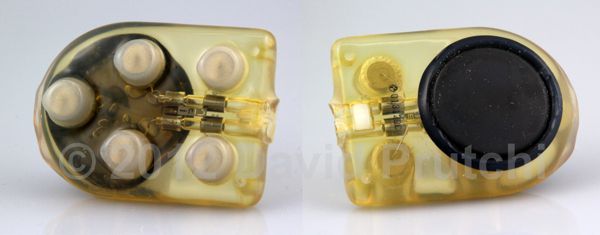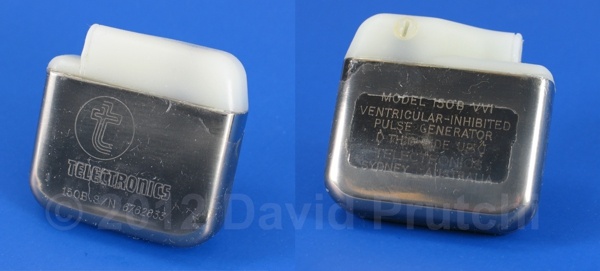 In 1965, Australian medical device pioneer Noel Gray established Telectronics – Australia’s first manufacturing facility for producing pacemakers that were designed in-house. Telectronics was an innovative developer, achieving some major successes in the early cardiac pacing field, for example, Telectronics’ leads allowed narrowing the pacing pulse to its current nominal of 0.5 milliseconds; encapsulating the pacemaker in titanium instead of epoxy; using a microplasma weld to join the two halves of the pacemaker capsule; creating one of the first rate-responsive ‘demand’ pacemakers; and isolating the pacemaker’s battery in a separate compartment to deal with the problem of leaking mercury-zinc batteries. Continue reading
In 1965, Australian medical device pioneer Noel Gray established Telectronics – Australia’s first manufacturing facility for producing pacemakers that were designed in-house. Telectronics was an innovative developer, achieving some major successes in the early cardiac pacing field, for example, Telectronics’ leads allowed narrowing the pacing pulse to its current nominal of 0.5 milliseconds; encapsulating the pacemaker in titanium instead of epoxy; using a microplasma weld to join the two halves of the pacemaker capsule; creating one of the first rate-responsive ‘demand’ pacemakers; and isolating the pacemaker’s battery in a separate compartment to deal with the problem of leaking mercury-zinc batteries. Continue reading
Author Archives: David Prutchi
Micro Systems Technologies Offers Active Implantable Medical Device Development/Manufacturing Services
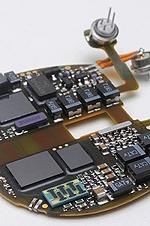
Image Credit: Micro Systems Technologies
Micro Systems Technologies (MST) is the vertically-integrated supplier of microelectronics and implantable-grade components to Biotronik. It now offers its development and manufacturing services to others.
Through its companies, MST offers high-reliability microelectronic modules for implantable medical devices such as pacemakers, defibrillators, neurostimulators, and cochlear implants.
MST can provide integrated solutions encompassing everything from conceptual design through high-volume surface-mount (SMT) assembly of modules. Services include design development of customer-defined electronic modules, custom ASIC design and development, and high-density-interconnect (HDI) substrate and assembly design.
As a OEM, MST offers state-of-the-art automated SMT line, an ISO 13485–compliant process and component verification and validation methodology, a manufacturing execution system that automates data collection, analysis, and process control, and comprehensive supply-chain management and monitoring with 100% traceability. Continue reading
VeriTeQ Acquisition Corporation Acquires Implantable, FDA-Cleared VeriChip Technology

Image Credit: VeriMed
On January 17, 2012, VeriTeQ Acquisition Corporation of Delray Beach, FL announced that it acquired the VeriChip implantable RFID technology and its related Health Link personal health record from PositiveID Corporation. Continue reading
DF-4 Connectors for Implantable Cardioverter Defibrillators Enter Use in the US

Image Credit: St. Jude Medical
Boston Scientific’s Active Implantable Sales for 2011: CRM Down 7%, Neuromodulation Up 10%

Today Boston Scientific Corporation announced financial results for the fourth quarter and full year ended December 31, 2011. Summarizing the AIMD data:
- On a constant-currency basis, Q4 2011 CRM sales were $482M compared to $564M in Q4 2010, or down 15%
- On a constant-currency basis, 2011 CRM sales were $2,087M compared to $2,180M in Q4 2010, or down 7%
- On a constant-currency basis, Q4 2011 Neuromodulation sales were $91M compared to $86M in Q4 2010, or up 6%
- On a constant-currency basis, Q4 2011 CRM sales were $336M compared to $304M in Q4 2010, or up 10%
Click here for the news release.
Remon Medical’s Implantable Pulmonary Pressure Sensor (1997-2007)
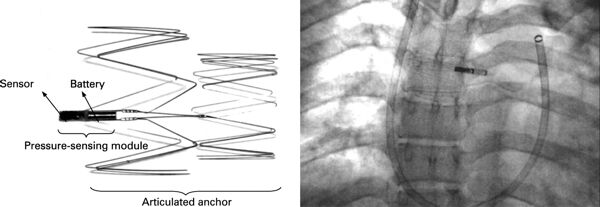
Remon Medical Technologies, Ltd. was founded in 1997 in Caesarea, Israel to develop implantable, wireless pressure sensors.
Remon developed an implantable hemodynamic monitor, which allowed on-demand, non-invasive, leadless self-monitoring of pulmonary artery pressure by the patient at home. ImPressure devices were placed in the pulmonary artery, and transmitted pressure readings to a hand-held monitor. It was hoped that the system would provide early warning of the need for treatment, avoiding hospitalization and deterioration in the patient’s condition. Continue reading
Purdue University’s Concept for Music-Powered Implantable Devices
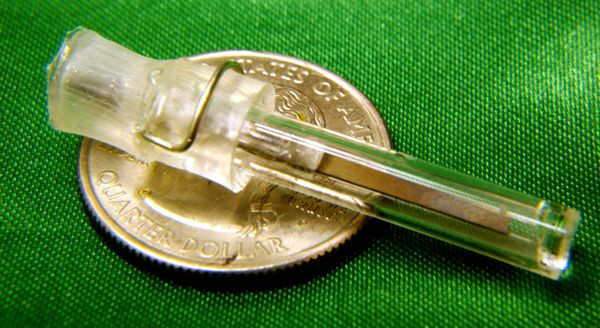
Image Credit: Purdue University
A group of researchers at Purdue University led by Prof. Babak Ziaie developed a vibrating cantilever that is excited by an external bass source from 200-500 Hz. The excitation causes the cantilever to vibrate, generating electricity and storing a charge in a capacitor.
Although playing tones within a certain frequency range would be ideal, the group concentrated on the use of music as an excitation source. According to the researchers, “a plain tone is a very annoying sound. We thought it would be novel and also more aesthetically pleasing to use music.” Continue reading
SMSI® Implantable Glucose Sensor
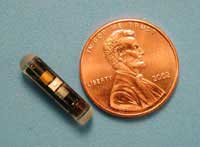 Sensors for Medicine and Science, Inc. (SMSI) of Germantown, MD was founded in 1997 to develop chemical sensing technologies based on fluorescence sensing.
Sensors for Medicine and Science, Inc. (SMSI) of Germantown, MD was founded in 1997 to develop chemical sensing technologies based on fluorescence sensing.
SMSI® is now developing an implantable glucose sensor that is designed to automatically measure interstitial glucose every few minutes. The sensor implant communicates wirelessly with a small external reader, allowing it to track the rate of change of glucose levels and warn the user of impending hypo- or hyperglycemia. According to SMSI, the target operational life of the sensor implant will be 6-12 months, after which it would be replaced. Continue reading
OT: We Received the First Copies of Our New Book!
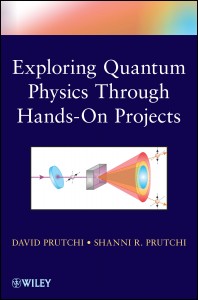 Today we received the first two copies of the book that I wrote with my 16-year-old daughter Shanni! It is a do-it-yourself book on Experimental Quantum Physics, and was published by John Wiley & Sons.
Today we received the first two copies of the book that I wrote with my 16-year-old daughter Shanni! It is a do-it-yourself book on Experimental Quantum Physics, and was published by John Wiley & Sons.
From the back cover:
“Build an intuitive understanding of the principles behind quantum mechanics through practical construction and replication of original experiments.
With easy-to-acquire, low-cost materials and basic knowledge of algebra and trigonometry, Exploring Quantum Physics through Hands-on Projects takes readers step by step through the process of re-creating scientific experiments that played an essential role in the creation and development of quantum mechanics.
Presented in near chronological order—from discoveries of the early twentieth century to new material on entanglement—this book includes question- and experiment-filled chapters on:
- Light as a Wave
- Light as Particles
- Atoms and Radioactivity
- The Principle of Quantum Physics
- Wave/Particle Duality
- The Uncertainty Principle
- Schrödinger (and his Zombie Cat)
- Entanglement
From simple measurements of Planck’s constant to testing violations of Bell’s inequalities using entangled photons, Exploring Quantum Physics through Hands-on Projects not only immerses readers in the process of quantum mechanics, it gives them insight into the history of the field—how the theories and discoveries apply to our world not only today . . . but also tomorrow.
By immersing readers in groundbreaking experiments that can be performed at home, school, or in the lab, this first-ever, hands-on book successfully demystifies the world of quantum physics for all who seek to explore it—from science enthusiasts and undergrad physics students to practicing physicists and engineers.”
For more information, please visit our d.i.y. Modern/Quantum Physics projects website at: www.diyPhysics.com
St. Jude Medical’s Active Implantable Sales for 2011: CRM Down 3%, Neuromodulation Up 8%

St. Jude Medical today reported sales and net earnings for the fourth quarter and year ended December 31, 2011. From the press release:
“Cardiac Rhythm Management
Total CRM sales, which include implantable cardioverter defibrillator (ICD) and pacemaker products, were$728 million for the fourth quarter of 2011, a 4 percent decrease compared to the fourth quarter of 2010. After adjusting for the impact of foreign currency, total CRM sales decreased 6 percent. Total CRM product sales for the full-year 2011 were $3.034 billion, essentially equal to 2010. On a currency neutral basis, total CRM sales declined 3 percent from the prior year. Continue reading
Biophan’s Implantable Biothermal Power Source
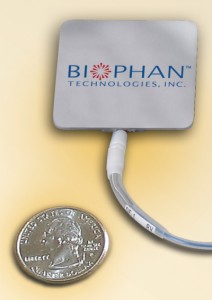
Image Credit: Biophan
Today I was going through some papers and found a 2005 brochure for Biophan’s implantable biothermal source – a 3 mm-thick power source for implantable devices capable of generating electricity from body heat. This power source was being developed by Biophan in collaboration with the NASA Ames Research Center for Nanotechnology.
The device is covered by U.S. Patent No. 6,640,137, “Biothermal power source for implantable devices” to Stuart G. MacDonald. It is a power source based on the Seebeck Effect, which allows electrical energy to be generated by heat crossing and array of n and p junctions of a specialized semiconductor. Biophan and NASA developed materials that matched the size, shape and number of semiconductor junctions to develop sufficient energy to power a pacemaker despite the very slight temperature difference between the body and the subcutaneous layer. Continue reading
Elema-Schoenander and the Very First Human Implants of a Pacemaker in Sweden (1958) and Uruguay (1960)
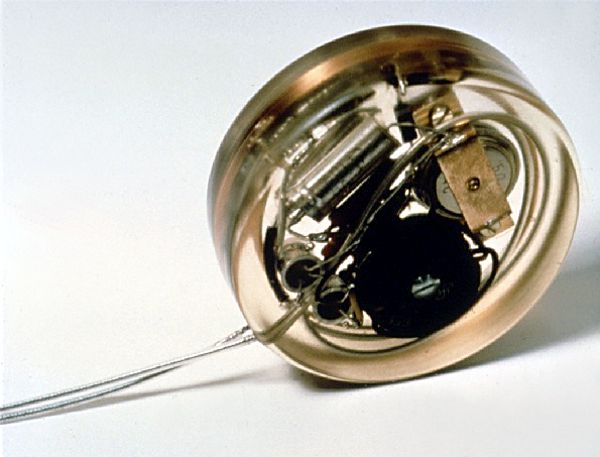
This is a picture of the first pacemaker to be implanted in a human patient. It was developed by Dr. Rune Elmqvist (1906–1996), a physician by training, but working for the Swedish company Elema-Schonander as an engineer. Dr. Elmqvist developed the device in cooperation of Åke Senning, senior physician and cardiac surgeon at the Karolinska University Hospital in Solna, Sweden. Continue reading
“Data Block” Percutaneous Implantable Electrical Connector
The development of medical devices, drugs, and treatments depends on accurately retrieving clinical data from implanted animals. Implantable data collecting and sensing devices provide one way to retrieve these data. These device often include sensors or electrodes which must be implanted within the subject in order to provide clinicians with access to the sensed information.
Retrieving data from implanted sensors poses a potential problem since data frequently must be retrieved on numerous different occasions and over an extended period of time. If surgery is required each time data is retrieved, the subject may be overly exposed to stress, trauma, or risk of infection. In order to develop and test cardiac pacemakers and defibrillators, for example, clinicians need to monitor electrical activity of the subject’s heart. One way to monitor this activity is to surgically implant one end of a lead to the heart. The other end of the lead may be left subcutaneously (i.e., under the skin) or transcutaneously (i.e., through the skin). In the former instance, access to the electrode may require an invasive procedure, such as surgery. In the latter instance, prolonged and chronic exposure of the electrode through the skin may cause discomfort, lead to infection, or cause damaging stress on the electrode. Continue reading
MicroCHIPS’ Implantable Drug Delivery Device for the Treatment of Osteoporosis
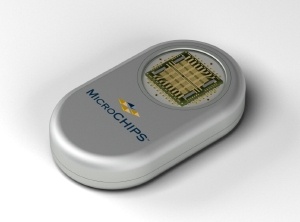
Image Credit: MicroCHIPS
MicroCHIPS was founded in 1999 as an MIT spinoff to develop implantable sensors and drug-delivery devices.
MicroCHIPS’ drug-delivery technology is based on proprietary reservoir arrays that are used to store potent drugs within the body for long periods of time. Individual device reservoirs can be opened on demand or on a predetermined schedule to precisely control drug release or sensor activation. Continue reading
Neuromed’s TIME Battery- and RF-Powered Totally Implantable Multichannel Spinal Cord Stimulator (ca. 1988)
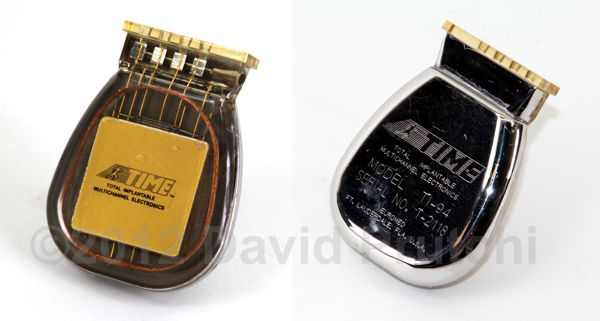
Neuromed TIME IPG on loan from Daniel Villamil's collection.
Neuromed was formed in 1980 with an initial capitalization of $150,000 by Bill Borkan through money obtained when Borkan`s parents took out a second mortgage on their home. Borkan’s desire to help his sister, Jennie, a cerebral palsy patient, got him started in neurostimulation technology. In the next few years, Neuromed developed and marketed a RF-powered implantable spinal cord stimulator, along with its external radio frequency transmitter.
Throughout the 1980s, development of more advanced devices was ongoing at Neuromed. My friend Daniel Villamil from CCC Medical has in his collection one of these more modern units, which he lent to me for photographing. The “Total Implantable Multichannel Electronics” (TIME) spinal cord stimulator shown in this picture went into clinical trials around 1988. This was a device that was internally powered by its own battery. However, it could also be RF-powered after the eventual battery failure. Continue reading

